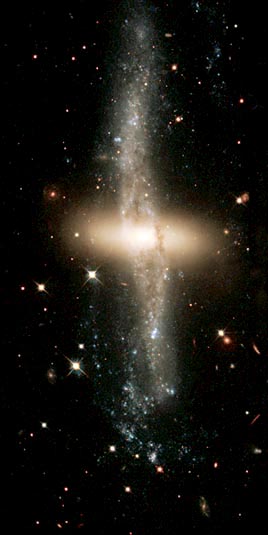
Polar-ring Galaxy
RA 12h 44m 52s Dec -40° 42' 52"
Centaurus
130 million light-years (40 Mpc)
Diameter of polar ring: 18 kpc (60,000 light-years)
1.6' × 0.8'
13.9
April 7-9, 1999
5.6 hours
F450W(B), F606W(V), F814W(I)
NASA and The Hubble Heritage Team (STScI/AURA)
May 6, 1999
ABOUT THIS IMAGE:
Space Telescope Science Institute astronomers are giving the public chances to decide where to aim NASA's Hubble Space Telescope. Guided by 8,000 Internet voters, Hubble has already been used to take a close-up, multi-color picture of the most popular object from a list of candidates, the extraordinary "polar-ring" galaxy NGC 4650A.
Located about 130 million light-years away, NGC 4650A is one of only 100 known polar-ring galaxies. Their unusual disk-ring structure is not yet understood fully. One possibility is that polar rings are the remnants of colossal collisions between two galaxies sometime in the distant past, probably at least 1 billion years ago. What is left of one galaxy has become the rotating inner disk of old red stars in the center. Meanwhile, another smaller galaxy, which ventured too close was probably severely damaged or destroyed. During the collision the gas from the smaller galaxy would have been stripped off and captured by the larger galaxy, forming a new ring of dust, gas, and stars, which orbit around the inner galaxy almost at right angles to the old disk. This is the polar ring which we see almost edge-on in Hubble's Wide Field Planetary Camera 2 image of NGC 4560A, created using 3 different color filters (which transmit blue, green, and near-infrared light).
This HST image clearly distinguishes structures in this extraordinary galaxy that only recently were discovered in images made using large ground-based telescopes. It also displays features that were previously unknown. The image confirms that the bright central concentration of light, which appears to be slightly orange in this image, has a completely smooth, regular appearance, indicating that it is a dense system composed of older stars and containing little gas or dust. We believe this was once a typical medium-sized galaxy that has been altered, probably by the process that made the complex polar ring. The central dark lanes are due to blockage of light by clouds of gas and dust in the ring, located between us and the inner galaxy. These are the sites of star formation in most galaxies, and NGC 4605A is no exception. The bright bluish clumps, which are especially prominent in the outer parts of the ring, are regions containing luminous young stars, examples of stellar rebirth from the remnants of an ancient galactic disaster. The polar ring appears to be highly distorted. No regular spiral pattern stands out in the main part of the ring, and the presence of young stars below the main ring on one side and above on the other shows that the ring is warped and does not lie in one plane. Determining the typical ages of the stars in the polar ring is an initial goal of our Polar Ring Science Team that can provide a clue to the evolution of this unusual galaxy.
Because the polar ring extends far into the halo of NGC 4650A, it provides a unique opportunity to map "dark matter," which is thought to surround most disk galaxies. It is called dark matter because it doesn't emit light, but only reveals itself through its gravitational effect on the stars and gas in the galaxy. Dark matter explains why disk stars in most spiral galaxies move at constant speeds around their galactic cores, regardless of their distances from the center axes of rotation. This motion is unlike the planets orbiting around our Sun, which move more slowly the farther they are away from the Sun, in response to the weakening of the Sun's gravitational pull with increasing distance. A constant speed requires extra gravitational pull and therefore implies the existence of unseen material in most galaxies that is supplying additional gravity. In NGC 4650A, both the old, rotating disk and the dark matter surrounding this galaxy pull on its polar ring. The alignment of the ring along the pole of the inner disk's rotation allows scientists to probe this combination of tugs and thus the distribution of dark matter.
The
name NGC 4650A means that this galaxy is the brighter of a pair of galaxies
numbered 4650 in the "New General Catalogue of Nebulae and Clusters
of Stars," known to astronomers as the "NGC." This catalog
was published by J.L. Dreyer in 1888. It is mainly based on observations
obtained by William and John Herschel as they looked at the skies with
their telescopes while Caroline Herschel checked and reduced the celestial
positions of interesting objects. In only 100 years we have gone from
astronomers peering at the sky through telescopes on the ground to using
electronic cameras on robotic telescopes in space!